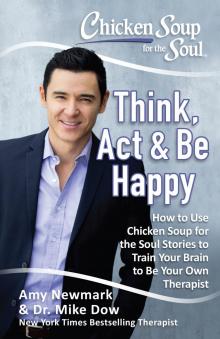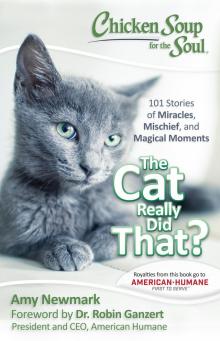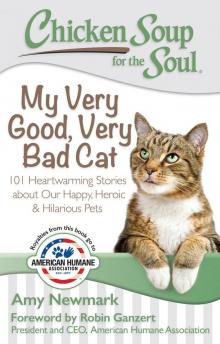- Home
- Amy Newmark
My Very Good, Very Bad Cat Page 15
My Very Good, Very Bad Cat Read online
Page 15
My husband, Joe, came in from feeding the horses one morning, scowling as he cradled something against his chest. “Some people,” he muttered, as he showed me a tiny, frightened calico kitten that was small enough to nestle in one of his big hands. We live in the country and it isn’t unusual to find abandoned pets, but we never get used to the callousness it takes to leave an animal on its own to slowly starve or become wild. The most heartbreaking of all is to find babies who either were tossed out to die or whose mother was killed.
“I couldn’t find any more,” Joe said. “The mother and any other kittens that there may have been are most likely dead. This one wouldn’t have made it much longer.” He put the kitten in my hands. “I’ll go into town and get a dropper and some formula. She might make it if we can get some food into her soon.”
While Joe was gone I found a shoebox and an old soft receiving blanket and made a bed for the kitten. In a few days she was putting on weight and mewling happily when I took her out of her bed to be fed and cuddled for a while.
Poppy’s puppies were getting fat and beginning to frolic, though never venturing far from her watchful eye. One morning, out of curiosity, I placed the kitten next to the pups to see how they would react to each other. The pups looked curiously at the funny little thing that made such odd sounds. They examined her for a few moments, then lost interest and wandered back to Poppy for some milk. To my surprise the kitten followed the pups timidly, mewling all the while.
When Poppy saw her brood approaching she dutifully lay down so they could nurse. She eyed the kitten and decided the tiny thing posed no threat to her pups, so she relaxed and turned her attention to her babies as they nuzzled around for a spot to nurse. To my surprise, the kitten started pushing forward between two of the pups, instinctively knowing what her reward would be if she could snag a teat.
I jumped up, ready to snatch her away. I didn’t know how Poppy would react to this intrusion. Poppy looked alarmed for few seconds as if she didn’t know how to react either. She looked up at me for guidance. I patted her head and talked softly to her. “It’s okay, girl. She’s just another hungry baby.”
I never had to feed the kitten after that. Poppy totally accepted her into her family. As time went on Poppy became very protective of her special baby. And the kitten followed the pups everywhere they went and seemed to think that she was a puppy too. We began to call her Rover because she clearly identified with the dogs.
When Poppy watched her babies play she kept a close eye on Rover, who was diminutive next to her large puppies, who turned out to be part Husky. Often, if one of the pups got too rough with Rover, Poppy would run over to inspect her smallest baby to make sure she was all right. Then she would give the offending sibling a warning look.
Initially we had planned on finding a home for Rover when she was weaned. But Poppy got so attached to her little calico “puppy” that we didn’t have the heart to separate them. To this day the two of them are inseparable. And Rover still thinks she is a dog.
~Elizabeth Atwater
Three Little Kittens
Fun fact: People who are allergic to cats are actually allergic to their “dander,” which is a mixture of cat hair, saliva and skin particles.
It was the first cold evening in October, and I was wearing only a cardigan. By the time we got home from Bible class, my teeth were chattering. I rushed inside with the kids, leaving my husband to tend to whatever chores needed finishing outside. A few minutes later, I heard a knock on the front door. I looked out the window, puzzled — even more so when I saw my husband standing there. He was grinning and pointing down. My eyes followed, and I gasped.
“Kids! Come look!” I said. “Kittens!”
There were three of them. Two Tabbies — one gray and one orange. The third one was the color of charcoal. He was the bold one, already weaving around my husband’s long legs while the other two vocalized their support. My eyes rose to lock with his.
What would we do with them?
We were allergic. I had explained this to the kids often when they asked why we didn’t have a pet. I had no doubt it was true. Whenever my son spent the night with his cousin (two cats, one dog), we had to dose him with Benadryl. I also struggled whenever I slept over at my sister’s house, with my nose tickling all night as I eyed her cat suspiciously.
There was no way we could take in three cats!
That’s what my mind said. Meanwhile, my mouth was betraying me. “Lead them to the back porch!” I heard myself say.
My husband complied, proving himself to be either a natural cat wrangler or the Pied Piper. They followed him without fuss.
My mind said no but my hands and feet sided with my mouth. Before I knew it, I was grabbing a Costco box, an old blanket and a towel. I pushed them into my son’s hands and pointed him to the back door.
“Get out a plastic cereal bowl,” I told my daughter. “Fill it with water.” Meanwhile, I rummaged in the pantry, coming up with a can of tuna.
My mind was telling me to stop. My mouth said, “They must be hungry.”
I opened the tuna and followed my kids outside. The kittens responded immediately, circling my legs and softly mewling their pleasure over what they could smell.
“Okay, okay.” I stooped to place the dish in front of them. “You like tuna?”
Watching the kittens gobble up the tuna, I forgot it was cold. The gray boy was pushy with his two Tabby sisters, so I intervened, pulling him away so they could get their fair share. It wasn’t difficult to coax them all into the blanket-lined box we set up in the corner. My kids were thrilled with all of it, exclaiming happily over every yawn or meow, cooing every time the kittens stretched or curled up in a ball to sleep.
When I checked on them the next morning, they were still there.
Now what were we going to do?
Buy cat food.
The kittens wandered over the next couple of weeks, but always came back at night to sleep on our porch. The gray Tabby was the least likely to roam far. From time to time, I would hear her on the back porch, crying toward the stream, beckoning her siblings home. She remained skittish when we tried to pet her, but was bold in other ways. Occasionally, she would dash inside the house when I opened the door.
“No,” I told her. “That will never be okay.”
Would it surprise you if I said that today, three years later, she’s curled up in the middle of my unmade bed?
We found a home for the orange Tabby with a friend of a friend. She is now a fat and happy house cat named Mango. Her brother ran off one day and, sadly, we never saw him again. By that time, I knew I couldn’t part with our little gray Tabby, despite my sniffling nose. We named her Katniss and cautiously invited her indoors from time to time while I wracked my brain trying to figure out how to handle all the cat dander. By Christmas, she was letting us hold her, sleeping under the tree, batting at the glittering balls, and begging to go outside so she could pounce through the fresh snow.
Over the years, Katniss has been the perfect pet for us. Yes, we’ve had to figure out how to deal with our allergy issues, but it hasn’t been as bad as we feared. And we all agree that caring for a cat is easier than caring for a dog — we even have a wonderful cat-loving friend who checks in on her when we travel. Having Katniss has also been wonderful for my autistic son, who has always been nervous around dogs. Having a gentle, purring fur ball to snuggle with has been especially helpful for him.
One night, not long after we decided we would keep Katniss, she was lying in my daughter’s arms, her head flung back against the crook of her elbow, her tummy exposed and enjoying a good scratch.
“God works in mysterious ways,” my daughter said solemnly.
My lips twitched. “How’s that?” I asked.
“Well,” she said. “I prayed for a dog, and He sent us a cat.”
~Jennifer Froelich
The Truth about Cats and Dogs
Fun fact: A person who loves cats is called an ailuroph
ile. The Greek historian Herodotus called cats “ailuroi,” which means “tail wavers.”
All of my friends are dog people. They own Corgis and Shepherds and Puggles, shuttle their dogs between each other’s apartments, and even take them away on vacation, only leaving their canines home alone when absolutely necessary. I’ve always liked animals, but I never understood this obsession. Why can’t you just leave your dog at home when you run to the grocery store or go have coffee with a friend? Don’t you want to at least take a trip without having to worry about feeding and walking and picking up your pup’s poop from the sidewalk?
I guess you could say that I just wasn’t a dog person, and because of this, I didn’t always fit in. There were many conversations I couldn’t join and Dog Dates I couldn’t attend, so when I decided to adopt my cat Cleo from a local shelter, I thought it would certainly alienate me further from the group. Little did I know that the opposite was true.
Within a few days of adopting Cleo, I began noticing that she had a number of traits unusual for a cat. She wasn’t quiet or disinterested, and she didn’t ignore me for most of the day the way my previous cats often had, happy just to bathe in the sun and nap. She wanted attention. She wanted to steal the food off my plate and chew on my shoes. She waited at the door, meowing fervently when she heard me walking up. She followed me around from room to room, staring at me with big, sad eyes until I got out her feather toy and played with her. At night, I would often wake up with her body curled in the curve of my knees, peacefully snoozing, her belly exposed and ready to be scratched.
Because she was so dependent on me, I started to feel bad when I left her alone for long periods of time. Though I didn’t need to rush home from work to make sure she didn’t have an accident on my beautiful white shag rug (thank goodness for litter boxes), I knew that she missed me and would be watching the door, waiting for the sound of my key in the lock. A few times, I even turned down the offer of happy-hour drinks with my co-workers to go home and check on my cat. For a while, nothing about this seemed strange.
Then one day it struck me.
Oh my God, I thought, watching my cat chase her tail in a circle. My cat is just like a dog. I am just like a dog person.
My friends didn’t understand. “What do you mean, your cat’s like a dog?” they asked. But when I tried to explain, they just scoffed. All the cats they knew were prissy, aloof and, from their perspective, utterly unlikeable.
“No offense,” my friend Jane said. “I’m just not a cat person.”
That day, I was forced to confront the fact that Cleo would never completely fit in. She would not be able to go on a Dog Date to the park and likely wouldn’t be happy on long road trips with the group. But despite these obstacles, I decided there was one thing Cleo could do: She could help change my friends’ minds about cats.
I started by inviting them over one at a time, worried that if Cleo were confronted by the whole group at once she would feel outnumbered and uncomfortable and take up residence behind my bed until everyone left.
It worked like a charm. Cleo ran right up to each friend that came over, sniffing and meowing and trying to make sense of the foreign-smelling dog hairs on each stranger’s pants and shirt. Once she was satisfied, she began licking the friend’s hands. They always laughed at the strange feel of Cleo’s rough feline tongue. “I’ve never met a cat who likes to lick,” they all said. “It really does feel like sandpaper!”
My friends saw how charming and fun Cleo was, not at all like the stereotypical cats they had imagined, and admitted to enjoying the many quirks unique to cats: sandpaper tongues, subtle ear movements, the soft kneading of paws on your lap when a cat is blissfully happy. One by one, they converted. All of them, that is, except Jane, who went everywhere with her dog Pepper, and used that as an excuse to not meet Cleo.
“Just bring Pepper with you,” I finally suggested. And though she resisted at first, we ultimately set a time for her and her long-haired Chihuahua to meet Cleo.
I was extremely nervous about the meeting, as Cleo now had to impress not one but two harsh judges. When the pair finally arrived, Cleo held her ground. Both animals hesitated, skirting each other’s general vicinity with narrow, hesitant eyes until they finally got close enough to sniff each other’s rumps. This sizing up went on for a few nerve-wracking minutes while Jane and I watched in silent awe. Then, Cleo and Pepper started to play.
“I can’t believe it,” Jane said in disbelief. “Your cat really is like a dog.”
There’s no denying that Cleo taught us all valuable lessons. She taught me to appreciate dog people and the energy it takes to properly care for such a loving, sweet, and — let’s face it — needy companion. As for my friends? Well, they now understand that not all cats are alike. That old curmudgeonly Tabby their childhood neighbor once had is not indicative of the entire feline species. Just like dogs, each cat has an individual, disparate, and often very endearing personality.
Now, when people ask me whether I’m a dog person or a cat person, I shake my head, explaining that it’s not that simple. I tell them about Cleo, how she has become an honorary member of the dog pack, and how my dog-loving friends opened themselves up to her. When confronted with non-believers, I just smile. “Come meet her,” I tell them. “You’ll see.”
~Clara Blake
Home Invasion
Fun fact: In general, a cat that approaches complete strangers is most likely a stray or abandoned domesticated cat, not a feral.
One might consider “Mousey” a strange name for a cat, perhaps even an insult. I consider the name appropriate for the way our cat became a member of our family. My son and I were watching television one night with a friend when I noticed something moving by my friend’s chair. Upset because I thought I’d seen a mouse, I sat up straight and stared down to see what had caught my eye. A young gray cat sat looking at me, uncertain whether to stay or run.
“Where did that cat come from?” I asked suspiciously, looking at my son for confirmation of his guilt. He had been asking for a cat for years and I had been unrelenting in turning him down. We had already been through too many pets and wildlife rescues.
“Cat?” he asked.
“What?” asked my friend.
Both males looked in the direction I pointed, with equally surprised looks on their faces.
I stood up. The cat backed up. I walked forward. The cat turned, ran into the laundry room, and out the pet door.
The pet door wasn’t new. It, and the one in the outer garage door, came with the house. I’d never known them to be used. Evidently, the scent of our chicken dinner, the sound of talking, and the chilly temperatures outside had encouraged the cat to chance entering.
I felt sure she wouldn’t be back, and she wasn’t… that night. The next night, however, a gray shadow once again peeked from around my friend’s recliner.
“Outside, cat. You’re not staying,” I insisted. My statement, meant to sound emphatic and made more for the benefit of the males in the room than the cat, might have been a little louder than necessary, but I was going to win this war.
“Mom, it’s cold, and the cat looks hungry. Can’t we give her something to eat and let her sleep in the laundry room for the night?”
“Not a chance. It’s not happening! That cat can find food elsewhere and sleep in the garage.” I wasn’t giving in, although I had to admit my conscience bothered me at the thought of sending a poor little creature outside in the cold without food.
“I’ll take her out,” my son volunteered.
I thought I saw him grab a piece of chicken as he walked through the kitchen, but I wasn’t sure and, like I said, my conscience was bothering me.
The cat didn’t come back that night. Score round two for me. The next evening, I found myself keeping an eye on the corner of the recliner, prepared for an ambush. No cat. I gave up and became engaged in the movie. Suddenly, as quiet as a mouse, a gray ball of fur landed on the footrest of my chair. I nearly jump
ed out of my skin! My friend chuckled and my son laughed out loud. The cat curled up and snuggled down by my leg, pretending to be oblivious to her surroundings.
The ball was in my court. I reached down to stroke her soft gray fur. The purring of the cat sounded loud, despite the volume of the television. The cat had adopted a family for herself, and she knew it. I never had a chance.
~Rita Durrett
Chosen
Fun fact: Cats are very particular about people and will often choose a special someone to bond with.
All my life, my family and I have adopted things — people, wounded animals, strays (both the human and animal variety) — so it shouldn’t be any wonder that we currently have two rescue dogs and a feral cat that followed me home two years ago.
I can remember feeding baby raccoons when I was eight. I can remember researching everything from hermit crabs to baby rabbits to hamsters so that we could make a proper shelter for each and nurse them back to health. When I grew up and became a teacher, I remember carrying a baby squirrel around my classroom when my students brought it in to me after finding it injured.
People were no different… I can remember a Thanksgiving at which we had twenty people, some of whom we didn’t really know, but they had no place to go so we took them in. And there was the Thanksgiving at my sister’s with a mixture of Spanish-speaking immigrants, former inmates, and a couple of elderly people who lived in a nursing home. Both days were full of laughter and unexpected perspective. Then, there’s work. As educators, my mother and I were constantly adopting families and sending bags of food, clothes and books or supplies home with children.

 Chicken Soup for the Soul
Chicken Soup for the Soul The Joy of Less
The Joy of Less Hope & Miracles
Hope & Miracles The Cat Really Did That?: 101 Stories of Miracles, Mischief and Magical Moments
The Cat Really Did That?: 101 Stories of Miracles, Mischief and Magical Moments The Joy of Christmas
The Joy of Christmas My Very Good, Very Bad Dog
My Very Good, Very Bad Dog My Very Good, Very Bad Cat
My Very Good, Very Bad Cat